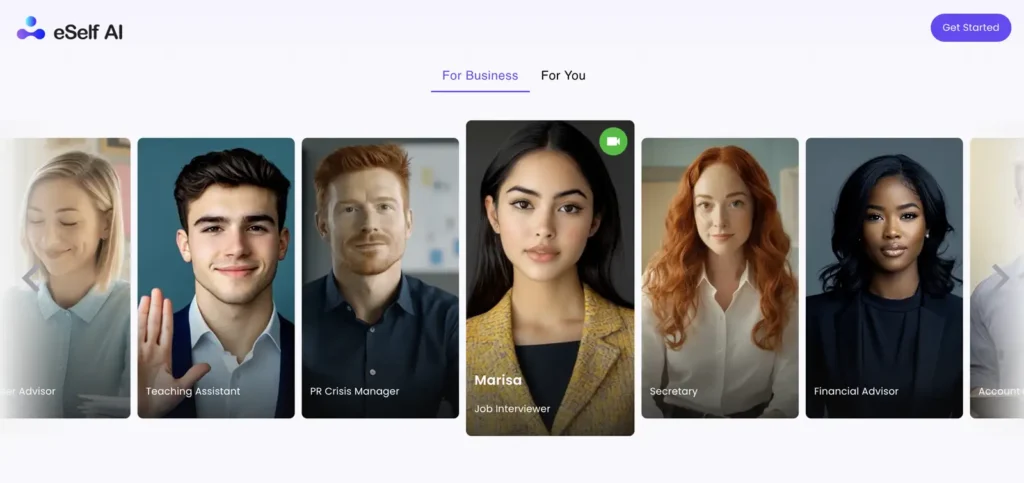Face-to-face communication has been an integral part of human interaction for thousands of years, fostering connection, understanding, and authenticity. With the rise of texting and other forms of digital communication over the past three decades, we’ve witnessed a decline in meaningful interactions, often leading to isolation and a loss of social skills. At eSelf AI, we’re here to change that. By combining cutting-edge technology with the art of human-like interaction, we deliver a seamless and natural conversational experience.
In this article, we’ll explore a critical component of AI-driven interactions: response latency. We’ve conducted comprehensive tests comparing eSelf AI’s latency performance with leading competitors—Heygen, DiD, and Anam AI. The results speak volumes about how eSelf AI ensures a superior user experience.
Latency Comparison: eSelf AI vs. Competitors
Latency, or the time it takes for an agent to respond, significantly impacts the natural flow of conversation. A delayed response can feel awkward, disrupt the rhythm of the interaction, and reduce overall satisfaction. Here’s a breakdown of our test results:
| Model | Mean Response Time (seconds) |
| eSelf AI | 1.69 |
| ChatGPT-4o (Vocal Assistant) | 2.37 |
| Heygen | 3.06 |
| Anam AI | 3.86 |
| DiD | 4.16 |
Key Observations from Latency Testing
1. eSelf AI: A Leader in AI Response Times
With a mean response time of just 1.69 seconds, eSelf AI delivers lightning-fast responses, ensuring conversations remain engaging and uninterrupted.
2. Competitor Challenges: ChatGPT-4o, Heygen, Anam AI, and DiD
- ChatGPT-4o: At 2.37 seconds, ChatGPT-4o shows strong performance with a response latency significantly lower than Heygen, Anam AI, and DiD. However, it still falls short of eSelf AI, which is notably faster and ensures an even smoother conversational flow.
- Heygen: Despite being a strong contender, its response latency of 3.06 seconds is nearly double that of eSelf AI.
- Anam AI: At 3.86 seconds, Anam AI used fillers like “I see” before responding, reducing perceived delay but affecting authenticity. To ensure fairness, we excluded these fillers during testing. Even with them, Anam AI averaged 1.86 seconds, slower than eSelf AI.
- DiD: The slowest among the tested models, DiD recorded a mean latency of 4.16 seconds, making interactions feel less fluid.
Why Latency Is Critical for Realistic Interactions
A key differentiator of eSelf AI is our dedication to authenticity. Unlike competitors that rely on fillers to mask delays, our platform focuses on delivering genuine, human-like responses in real-time. By eliminating unnecessary pauses and maintaining conversational fluidity, we create a truly immersive experience for users.
Research shows that latency significantly affects user perception of an AI agent’s intelligence and efficiency. Our rapid response times contribute to a more engaging and enjoyable interaction, whether you’re using eSelf AI for customer service, virtual consultations, or any other face-to-face application.
The Future of AI-Driven Communication
At eSelf AI, we believe in transforming how people connect and communicate. By prioritizing speed, authenticity, and user experience, we’re setting new standards in the AI industry. Our technology is not just about faster responses; it’s about creating meaningful interactions that feel as natural as a conversation with another person.
The comparison speaks for itself: with a response latency of just 1.69 seconds, eSelf AI leads the pack. As the world moves towards more authentic and engaging communication tools, eSelf AI is paving the way for a brighter, more connected future.
Ready to Experience the Difference?
Discover how eSelf AI can transform your communication needs. Check out our blog for more insights and updates, or get started today!
The Future of Latency in AI-Driven Interactions
As AI technology continues to evolve, the potential for even lower latency in face-to-face interactions is vast. Advances in edge computing and quantum processing are poised to revolutionize response times, enabling sub-second latencies that feel indistinguishable from human reactions. Additionally, developments in machine learning algorithms and data compression techniques will allow AI systems to process complex inputs more efficiently, reducing the time needed to generate authentic, meaningful responses. These innovations promise a future where AI-driven interactions not only match but may surpass the speed and fluidity of human conversations, opening up new possibilities for industries such as healthcare, education, and virtual reality.
Conclusion: eSelf AI Setting New Standards in AI Communication
eSelf AI is redefining the benchmarks for AI-driven face-to-face interactions by prioritizing speed, authenticity, and user experience. With a groundbreaking response latency of just 1.69 seconds, it surpasses competitors and sets a new industry standard. By focusing on seamless, natural conversations, eSelf AI is not just improving communication tools but also reshaping how people connect in a digital world. As the demand for realistic and efficient AI interactions grows, eSelf AI stands at the forefront, paving the way for a more engaging and connected future.
